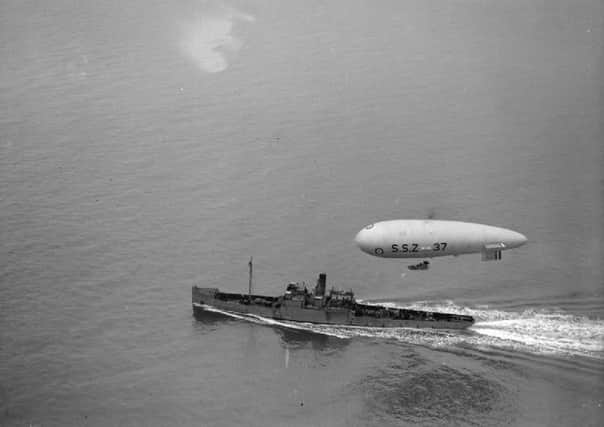Over here!


Although Imperial German Navy surface ships remained in port after the Battle of Jutland in May-June 1916, Germany possessed a submarine, or U-boat, fleet that menaced shipping coming into the United Kingdom.
Germany’s U-boats had demonstrated their capabilities early in the war. During September they sank four British warships. On the 5th the light cruiser HMS Pathfinder was torpedoed in the North Sea. Her magazines exploded; she sank in under five minutes and 259 crewmen perished.
Advertisement
Advertisement
Worse followed. On the 22nd three old armoured cruisers, HM Ships Aboukir, Cressy and Hogue, patrolling the eastern entrance to the English Channel, were lost. In less than an hour, U-9 torpedoed and sank all three with the loss of 1,459 lives.
U-9 then torpedoed and sank HMS Hawke on 15 October; 525 men died. The menace of the submarine, brought home well and truly to the Admiralty, was emphasised dramatically on 7 May 1915. On that day U-20 torpedoed the RMS Lusitania off the Old Head of Kinsale. The liner sank in less than twenty minutes, taking with her 1,198 souls, including 128 Americans. In the neutral USA there was outrage about the attack.
American reaction prompted the Kaiser to order the Imperial Navy to stop attacking merchant ships. This order held good for over a year but such were German losses on the Somme in 1916, forcing withdrawal to a new line, that unrestricted submarine warfare was renewed in 1917. Within weeks British shipping losses were so severe that a crisis developed. It was clear that Britain’s merchant fleet, the world’s largest, would soon be reduced to a skeleton and the UK forced to seek peace with Germany. Even the entry of the USA into the war in April would not save the situation.
This crisis forced the Admiralty to introduce the convoy system on transatlantic convoys. An American naval force was deployed to the UK to operate under Royal Navy command and, before long, the convoy escorts were showing results.
Advertisement
Advertisement
But the fight had to be continued. As well as ships, the US Navy sent aircraft to the UK, flying boats, to join Royal Naval flying boats and airships in providing air cover for convoys. Two main US Navy air stations were established in Ireland: Queenstown (now Cobh) in County Cork and Ture on the shores of Lough Foyle in County Donegal.


The building of Naval Air Station (NAS) Lough Foyle began in January 1918. Local labour and American construction teams worked on the site, building a control tower that still stands, accommodation and workshops, and a concrete slipway for beaching the aircraft – this is still in existence.
In July the first Curtiss H-16 flying boats arrived in Londonderry. These had been stripped down and had to be re-assembled, a task completed by 22 August when training began. On 1 September the base became operational. Between 3 September and 6 November the flying boats completed 27 patrols – flying was possible only on 31 days. The longest patrol, on 24 October, was over six hours, an unthinkable flight time only ten years earlier.
The RN airships operated from Ballyliffin (the modern golf club). These Sea Scout Zero (SS-Z) class ‘blimps’ carried out patrols of about eight hours. However, if needed, they could remain airborne for over twenty-four hours. Their presence re-assured seamen and deterred German submarines. Operations from Ballyliffin continued until the war ended.
Advertisement
Advertisement
US Navy flying boats from NAS Lough Foyle escorted 10 convoys. On 19 October Ensign Montgomery’s H-16 was escorting convoy HH-72. The aircraft was ‘1 mile ahead and 2 miles on the port side of the convoy [when] a periscope and a well-defined wake’ were spotted. Montgomery ‘signalled to the convoy and dropped 2 bombs in the vicinity and reported that oil and water bubbles appeared’.


Two warships dropped 20 depth charges on the target, but the destruction of the U-boat was credited by the Admiralty to the American flying boat. However, this first ever sinking of a U-boat by an American aircraft was not claimed by the US Navy.
On 3 November another H-16 attacked a ‘suspicious oil slick’. Airships from Ballyliffin joined the attack while HM Drifter Flower depth-charged the area and reported a ‘considerable quantity of oil’. Airship SSZ-12 reported that the slick was zigzagging on a flat calm sea, but the engagement was not confirmed as an attack on a submarine.
With the Armistice NAS Lough Foyle was run down and its airmen went home. Much of the base was dismantled with one hut being floated across the Foyle to Limavady to act as a club room. By January 1919 US personnel had left and the base became part of the history of the Great War and of the North-West, although it has been relegated to the footnotes of history in both categories.